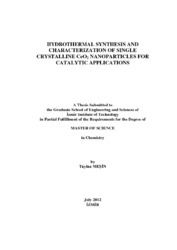Please use this identifier to cite or link to this item:
https://hdl.handle.net/11147/3503Full metadata record
| DC Field | Value | Language |
|---|---|---|
| dc.contributor.advisor | Eanes, Mehtap | en |
| dc.contributor.author | Meşin, Taylan | - |
| dc.date.accessioned | 2014-07-22T13:51:41Z | - |
| dc.date.available | 2014-07-22T13:51:41Z | - |
| dc.date.issued | 2012 | en |
| dc.identifier.uri | http://hdl.handle.net/11147/3503 | - |
| dc.description | Thesis (Master)--İzmir Institute of Technology, Chemistry, İzmir, 2012 | en |
| dc.description | Includes bibliographical references (leaves: 57-61) | en |
| dc.description | Text in English; Abstract: Turkish and English | en |
| dc.description | xi, 67 leaves | en |
| dc.description | Full text release delayed at author's request until 2015.08.03 | en |
| dc.description.abstract | Single crystalline cerium oxide nanoparticles were synthesized with hydrothermal method by mixing cerium nitrate[Ce(NO3)3.6H2O] aqueous solution with alkali bases CsOH and RbOH. SEM, TEM and XRD characterization methods were used in order to identify morphology. First part of the study includes the work on effect of hydrothermal parameters, such as reaction temperature, reaction time, alkali base type and concentration on particle size and morphology. It was prooved that the size of ceria nanoparticles is directly proportional with the reaction time. The reaction temperature is also an important parameter that effect the morphology of nanoparticles. At 120 oC nanoparticles form rod like structure and as time goes they start to form cubic crystals. When the alkali base and concentration was changed the results showed that higher base concentration favors the particles to form bigger structures than that of lower concentrations. In addition, optical properties of CeO2 nanoparticles were studied by using the UV-Vis and Fluorescence Spectrometry. UV-Vis Spectroscopy results show that particle size of CeO2 nanoparticles synthesized in the presence of 8M RbOH are larger than that of synthesized in presence of 8M CsOH. When the reaction time decreases the Ce3+ defect increases based on the results of Fluorescence Spectrometry results. Second part of the study includes catalytic property of CeO2 nanoparticles. Ceria nanoparticles were used as catalyst in the synthesis of flavone from 2’-hydroxychalcone. Several reaction parameters were studied in order to achieve the flavone synthesis. TLC, GC, GC-MS and NMR were used in order to monitor the results of the reactios. | en |
| dc.language.iso | en | en_US |
| dc.publisher | Izmir Institute of Technology | en_US |
| dc.rights | info:eu-repo/semantics/openAccess | en_US |
| dc.subject.lcsh | Cerium oxide crystals | en |
| dc.subject.lcsh | Nanoparticles | en |
| dc.subject.lcsh | Catalysis | en |
| dc.title | Hydrothermal synthesis and characterization of single crystalline CeO2 nanoparticles for catalytic applications | en_US |
| dc.type | Master Thesis | en_US |
| dc.institutionauthor | Meşin, Taylan | - |
| dc.department | Thesis (Master)--İzmir Institute of Technology, Chemistry | en_US |
| dc.relation.publicationcategory | Tez | en_US |
| item.grantfulltext | open | - |
| item.openairetype | Master Thesis | - |
| item.fulltext | With Fulltext | - |
| item.cerifentitytype | Publications | - |
| item.openairecristype | http://purl.org/coar/resource_type/c_18cf | - |
| item.languageiso639-1 | en | - |
| Appears in Collections: | Master Degree / Yüksek Lisans Tezleri | |
Files in This Item:
| File | Description | Size | Format | |
|---|---|---|---|---|
| 439776.pdf | 2.99 MB | Adobe PDF |  View/Open |
CORE Recommender
Page view(s)
128
checked on Jul 15, 2024
Download(s)
120
checked on Jul 15, 2024
Google ScholarTM
Check
Items in GCRIS Repository are protected by copyright, with all rights reserved, unless otherwise indicated.